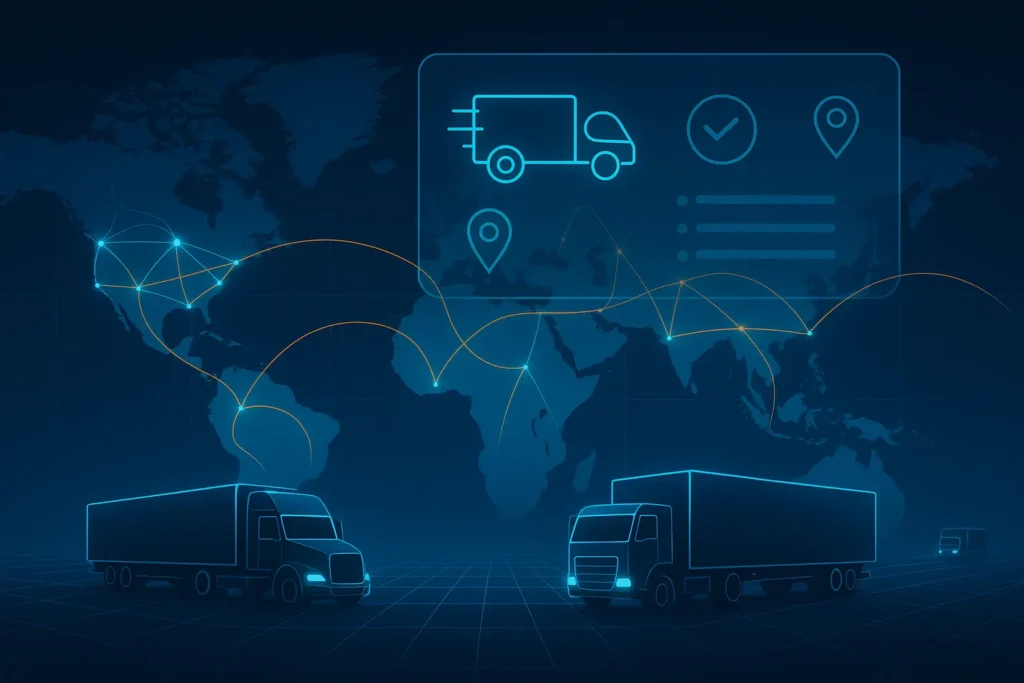In 2025, the food delivery industry continues to soar, with DoorDash leading the global market at over 65% U.S. market share and an annual revenue surpassing $9.6 billion. Entrepreneurs and startups are looking to replicate this success — not by imitation, but through innovation powered by clone technology.
A DoorDash Clone Scripts offers a complete food delivery solution that mirrors the core logic of DoorDash — from restaurant onboarding to real-time delivery tracking — while allowing full customization to fit your brand and business model.
With rapid demand for localized food delivery startups, Miracuves’ DoorDash Clone Script empowers founders to launch a full-featured, scalable platform within 3-6 days. Built with cutting-edge frameworks, it ensures 99.9% uptime, lightning-fast performance, and full source-code ownership, giving you the control to grow your business sustainably in 2025’s competitive landscape.
What Makes a Great DoorDash Clone?

A great DoorDash Clone in 2025 is more than just a delivery app; it’s an ecosystem of efficiency, intelligence, and scalability. To compete in today’s market, startups must integrate technology that offers real-time operations, personalized experiences, and frictionless monetization.
The Foundation of a Great Clone
A top-performing clone combines speed, scalability, and security. It must deliver consistent user experiences across web and mobile, process thousands of simultaneous orders, and adapt to regional delivery models — from hyperlocal services to nationwide logistics.
In 2025, customer expectations are higher than ever. A food delivery app must load under 300ms, handle 10,000+ concurrent users, and provide a 99.9% uptime guarantee. Behind the scenes, AI-driven automation, predictive logistics, and cross-platform integration keep operations running seamlessly.
Key Attributes of a Great DoorDash Clone
- Scalability – Auto-scaling infrastructure for peak order volumes.
- AI Automation – Smart order assignment, route optimization, and dynamic pricing.
- User Experience (UX) – Simple onboarding, intuitive design, and frictionless payment flow.
- Security & Compliance – Encrypted data layers and GDPR/PCI compliance.
- Multi-Platform Support – Fully responsive across iOS, Android, and Web.
2025 Feature Benchmark Table
| Clone Feature | 2025 Standard | Competitive Edge |
|---|---|---|
| Load Handling | 10K users/sec | Enterprise scalability |
| AI Automation | Included | Personalized UX & smart logistics |
| Uptime Reliability | 99.9% guaranteed | Cloud auto-scaling architecture |
| Cross-Platform Access | iOS, Android, Web | Unified backend APIs |
| Security Layer | End-to-end encryption | Blockchain-ready transaction logs |
Essential Features Every DoorDash Clone Must Have
A successful DoorDash in 2025 must be more than a simple ordering platform—it should function as an intelligent, data-driven ecosystem that enhances every stakeholder’s experience. Whether for users, restaurants, or delivery partners, each interface must deliver precision, speed, and usability at scale.
Core Functional Layers
User Side
The user interface should focus on simplicity and trust. From intuitive onboarding to personalized recommendations, it must minimize friction. Users expect one-click reorders, AI-based suggestions, and instant delivery tracking.
Admin Panel
This is the operational control hub. Admins must have access to analytics dashboards, automated commission management, restaurant performance reports, and fraud detection systems. The admin suite should enable data-backed decision-making for better operational efficiency.
Provider/Partner Side
Delivery partners and restaurants require transparency. Features like smart order routing, AI-based earnings predictions, and automated payout dashboards improve engagement and retention.
Advanced 2025 Feature Highlights
Modern DoorDash Clone Apps go beyond traditional delivery features. They include intelligent tools that enhance user experience and operational growth.
- AI-Based Personalization – Learns from order history to predict preferences.
- AR Onboarding – Visual restaurant previews and immersive menu showcases.
- Blockchain Verification – Transparent transaction tracking for secure payments.
- Predictive Analytics – Forecast demand, optimize delivery routes, and reduce idle time.
Feature Comparison Table
| Feature | Basic | Professional | Enterprise |
|---|---|---|---|
| AI Personalization | ✖ | ✔ | ✔✔ |
| White Label Branding | ✔ | ✔ | ✔✔ |
| Blockchain Security | ✖ | ✔ | ✔✔ |
| Multi-Language Support | ✔ | ✔✔ | ✔✔ |
| Predictive Analytics | ✖ | ✔ | ✔✔ |
Miracuves integrates these technologies natively into its DoorDash Clone architecture. Each feature is built using modular components, ensuring rapid customization and smooth scaling. The result is a ready-to-launch platform optimized for performance and long-term growth.
Read More : DoorDash Pricing Model and Strategy: How It Drives Success
Cost Factors & Pricing Breakdown
DoorDash-Like Food Delivery Marketplace Development — Market Price
| Development Level | Inclusions | Estimated Market Price (USD) |
|---|---|---|
| 1. Basic Delivery MVP System | User & restaurant apps, delivery partner app, order tracking, payments, admin console | $30,000 |
| 2. Full-Feature Delivery Platform | Multi-restaurant marketplace, route optimization, offers/coupons, analytics, reviews, notifications | $75,000 |
| 3. Enterprise Delivery Network | Automated dispatching, batching, surge pricing, franchise model, CRM, multi-city scaling, loyalty engine | $140,000+ |
DoorDash-Style Platform Development
The pricing above reflects the global market cost for developing a DoorDash-style real-time food ordering & delivery system — typically ranging $30,000 to $140,000+, depending on logistics automation, routing workflows, and regional expansion structure.
Miracuves Pricing for a DoorDash-Like Platform
Miracuves Price: Starts at $2,899
This pricing includes a ready-to-launch food delivery marketplace ecosystem featuring merchant, delivery partner & user apps, real-time order tracking, wallet & commission structure, analytics dashboard, and complete deployment support.
Note:
This includes full non-encrypted source code, deployment assistance, backend/API configuration, admin panel setup, and support for Google Play Store & Apple App Store publishing.Launch Your DoorDash-Level Delivery Platform — Contact Us Today
Delivery Timeline for a DoorDash-Like Platform
Estimated deployment timeline: 3–6 Days, based on:
- Restaurant onboarding & ordering workflows
- UI theme customization
- Payment gateway & wallet integration
- Dispatch rule configurations
Tech Stack
This solution is built with robust frameworks —
Web using PHP, MySQL & Apps using Flutter, optimized for stability, performance, and scalable future customizations.
Upgrade to Node.js / Next.js can be scoped as a premium enhancement.
Customization & White-Label Options
Launching a DoorDash-style food delivery platform requires deep customization because hyperlocal logistics ecosystems rely heavily on real-time routing intelligence, multi-merchant management, delivery efficiency, customer loyalty flows, and strong operational control. To compete in the rapidly evolving food delivery space, the platform must adapt to brand experience, regional logistics logic, and differentiated business models.
Miracuves provides a fully white-label DoorDash-style multi-vendor delivery system, enabling full customization across ordering workflows, driver dispatch logic, restaurant integration, branding identity, and fleet operations — ensuring optimized performance from startup level to enterprise scale.
Why Customization Matters
- Multi-store, multi-location restaurant onboarding
- Real-time courier assignment & optimized delivery engine
- Dynamic distance-based and surge pricing capabilities
- Advanced order tracking & ETA prediction
- Customer retention through loyalty & offers
- Delivery partner performance analytics
- Multi-language & multi-currency scaling
What You Can Customize
UI/UX & Branding
– Restaurant UI layouts, customized design themes, map UI styling, branded identity
Order & Delivery Flow
– Driver batching logic, kitchen prep time syncing, order status lifecycle
Fleet & Rider Management
– Verification, scheduling, heatmap analytics, fleet performance monitoring
Payments & Monetization
– Commission models, subscription systems, delivery fee rules, wallet top-ups
Communication & Support
– Live order messaging, driver-customer bridging, smart alerting
Marketing Automation
– Coupon engines, loyalty rewards, cashback & referral programs
3rd-Party Integrations
– Payment gateways, invoicing, CRM & ERP, geo-mapping tools
How Miracuves Handles Customization
- Requirement mapping & food delivery workflow planning
- UI/UX personalization aligned with brand experience
- Dispatch optimization engine setup & testing
- QA automation & performance scalability
- Deployment and hyperlocal scaling support
Real Examples From Miracuves Portfolio
- QuickServe (USA): Subscription delivery with advanced batching intelligence
- MealRunner (UAE): Multi-region delivery ecosystem with express logistics
- FoodRoute (India): Restaurant-focused ecosystem with reward-driven retention
With Miracuves’ DoorDash-style foundation, customization transforms your platform into a high-efficiency delivery engine designed for operational scale and superior customer experience.
Read More : How DoorDash’s Monetization Model Powers Its Market Dominance
Launch Strategy & Market Entry
Miracuves ships code and a go-live plan. The objective is predictable launch, fast adoption, and clear unit economics in one metro before expansion.
Pre-Launch Checklist
- Technical: Load tests for peak dinner windows, device matrix QA, fallback flows for payment and GPS loss, and disaster recovery runbooks.
- App Store Setup: Optimized titles, descriptions, screenshots, compliance notes, and privacy labels; server-side feature flags to avoid resubmission loops.
- Legal & Compliance: PCI scope definition, GDPR/CCPA disclosures, courier agreements, restaurant contracts, and SLA wording for refunds/chargebacks.
- Marketing Prep: Geo-fenced campaigns, creator partnerships, referral mechanics, launch-day promos, SMS/WhatsApp templates, and CRM segments.
Regional Entry Strategies
- Asia: Cash-heavy options and super-app cross-promo; emphasize multilingual UX, wallet integrations, and micro-influencer campaigns.
- MENA: High AOV premium positioning; Arabic-first UX, COD plus major cards, heat mitigation for courier SLAs.
- Europe: Privacy and accessibility audits, SEPA payments, iDEAL/SOFORT where relevant; bicycle delivery routing in dense cores.
- North America: Card-first flows, tipping culture optimization, suburban delivery rings, and loyalty tiers tied to subscription perks.
Growth & Monetization Frameworks
- Acquisition: Influencer tasting sessions, UGC contests, first-order subsidies with strict cohort tracking, and neighborhood ambassadors.
- Revenue Mix: Commissions, delivery fees, surge/distance fees, advertising placements, subscription bundles (free delivery + partner discounts).
- Retention: Stamp cards, streaks, birthday credits, win-back offers, and personalized bundles based on time-of-day and cuisine history.
- Operational Levers: Driver heat maps, restaurant prep-time accuracy models, and smart batching to lift delivered-per-hour and margin.
How Miracuves helps end-to-end
- Deployment: Managed cloud templates, CI/CD, observability stack, and SLO dashboards.
- Go-to-Market: Launch playbooks, CRM events, referral ladders, and store-onboarding kits.
- Optimization: Weekly metric reviews (CAC/LTV, AOV, delivery ETA accuracy), A/B tests on fees, promos, and recommendation models.
Read More : DoorDash Business Model Explained: Key Revenue Streams
Why Choose Miracuves for Your DoorDash Clone
Building a food delivery marketplace is a race against time and complexity. Miracuves compresses that journey with a production-tested codebase, a cloud-optimized architecture, and a delivery model shaped by real launches in multiple regions and categories.
Proof that matters to founders
- 600+ successful deployments across marketplaces, mobility, and on-demand verticals.
- 60 days of free post-launch support for monitoring, bug fixes, and version updates.
- Full source-code ownership to protect IP and enable long-term independence.
- 99.9% uptime architecture with autoscaling, observability, and failover patterns.
What this means for your execution
- Faster path from brand concept to transacting users.
- Lower implementation risk via prebuilt modules (ordering, menus, payouts, delivery routing).
- Enterprise-ready foundations (RBAC, audit logs, PII encryption, PCI-friendly flows).
- Modular services to add AI recommendations, loyalty, dark-kitchen orchestration, or B2B accounts without refactoring the core.
Success stories (condensed)
- City-first niche cuisine network
A founder launched in one metro with 120 partner restaurants. Using Miracuves’ dispatch and batching, average delivery ETA dropped by 18% in week two; first 90 days saw repeat-order rate rise to 34% after loyalty perks were enabled. - Campus and corporate delivery
A B2B operator needed budget controls and consolidated billing. Miracuves added corporate wallets and scheduled group orders in 10 days; the tenant retention rate improved and lunchtime throughput increased by 27% due to smarter batching. - Dark-kitchen alliance
A virtual brand collective required menu governance and surge fee logic. With Miracuves’ rules engine and heat-map routing, driver utilization lifted by 15% and ad placements unlocked a new revenue line without impacting conversion.
Why Miracuves over generic vendors
- Speed without lock-in: rapid launch, full code, no black-box dependencies.
- Operational clarity: dashboards for cohorts, AOV, prep-time accuracy, and courier SLAs.
- Scalability by design: sub-300ms responses, autoscale policies, CDN, and edge caching patterns.
- Global readiness: multi-language, multi-currency, regional payments, and tax profiles.
Ready to launch your DoorDash clone? Get a free consultation and project roadmap from Miracuves — trusted by 200+ entrepreneurs worldwide.
Final Thought
Launching a food delivery platform in 2025 isn’t about reinventing the wheel — it’s about executing faster, smarter, and with precision. The DoorDash Clone by Miracuves provides that edge: a ready-to-scale framework that compresses development cycles, minimizes costs, and lets founders focus on differentiation instead of debugging.
By understanding DoorDash’s proven business logic and pairing it with Miracuves’ production-grade clone solutions, entrepreneurs can enter the market with confidence. You get the benefit of a pre-validated architecture, modern tech stack, and full control to shape your platform’s direction — all within a fraction of the time it would take to build from scratch.
In a market projected to cross $1 trillion globally by 2030, early movers who adopt efficient, modular solutions will dominate local niches and regional delivery ecosystems. Miracuves enables exactly that — faster launches, cleaner scalability, and long-term business resilience.
FAQs — DoorDash Clone Script by Miracuves
1. How quickly can Miracuves deploy my DoorDash Clone?
Miracuves delivers a fully functional, white-labeled DoorDash Clone within 3-6 days, including installation, testing, and app-store submission support.
2. What’s included in the Miracuves DoorDash Clone package?
The package includes user, admin, and driver panels, complete source code, cloud deployment setup, payment gateway integration, and 60 days of post-launch support.
3. Can I get full source-code access?
Yes. Miracuves provides 100% source-code ownership, allowing you full control over customization, scalability, and long-term product independence.
4. How does Miracuves ensure scalability for large user bases?
The clone is built on a microservices architecture with auto-scaling, caching, and load balancing, ensuring performance stability even during high-demand spikes.
5. Does Miracuves assist with app store approval?
Yes. The team provides end-to-end publishing assistance, ensuring your iOS and Android apps meet all App Store and Play Store compliance standards.
6. Is post-launch maintenance included?
Every package comes with 60 days of free post-launch support, covering performance monitoring, bug fixes, and version compatibility updates. Extended maintenance plans are also available.
7. Can Miracuves integrate custom payment gateways or wallets?
Absolutely. Miracuves supports Stripe, PayPal, Razorpay, crypto gateways, and regional options like Paytm or Flutterwave, depending on your target market.
8. What’s the upgrade and update policy?
You’ll receive regular software updates with security enhancements, feature upgrades, and compatibility improvements. Major version updates can be implemented with minimal downtime.
9. How does white-labeling work with Miracuves?
Miracuves delivers a fully branded clone, customized with your logo, domain, app name, theme colors, and regional settings — ensuring your app looks and operates like a unique brand.
10. What kind of ongoing support can I expect?
Clients get dedicated technical support, update notifications, and long-term maintenance packages. The Miracuves team ensures your platform remains secure, fast, and aligned with 2025’s evolving market standards.
Related Articles
- Best Grubhub Clone Scripts in 2025: Features & Pricing Compared
- Best Chownow Clone Scripts in 2025: Features & Pricing Compared
- Best JustEat Clone Scripts in 2025: Features & Pricing Compared
- Best Swiggy Clone Scripts in 2025: Features & Pricing Compared
- How to Start a Regional Food Delivery Platform Business








